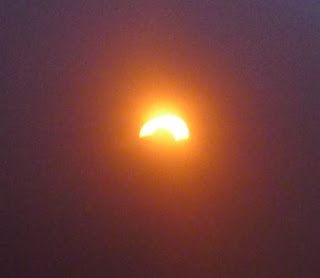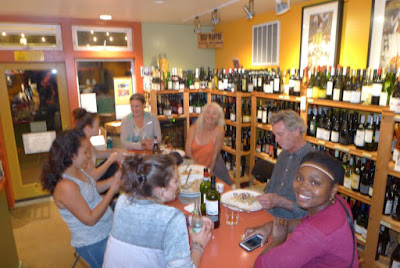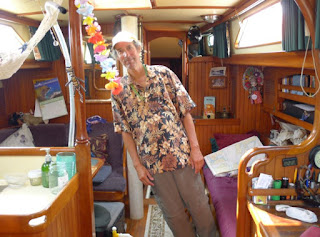 |
| Dent Rapids |
The internet at the Stuart Island Community Dock was not working so well so I didn't post my blog that day. Now we are up north, there is no easy internet and no phone service so I'll have to release whatever blog entries that have piled up once we get to Cortez Island and civilization. At Stuart Island Connie walked to Eagle Lake and, sure enough, saw dozens of eagles. I found reading material at the "Take a book, leave a book" library and offloaded some of my old stuff.
It is kinda scary but certainly fun running the narrow, fast moving channels. I'm a little tense, watching the clock as we head toward the skinny part of the channel where at full ebb or flood the water boils in standing waves and whirlpools abound. But we always pass at slack current, or slightly with current, so the timing is essential. When you are transiting the rapids, so is everyone else. It's a little daunting to see a mass of boats coming forward at you. I'm hoping they are watching where they are going! Then when they've passed, their wake action is added to the normal jiggidy jaggedy flopping around of the tidal currents and Traveler is fairly dancing around, heading this way and that.
On the radio we hear folks from the little marinas telling boaters to watch their wake! As these lodges and marinas are right on the channels, boats will come upon them without being aware and as we know, some of the power vessels throw quite a wake. At Codero lodge in Nodales channel that gal must sit in her office overlooking the channel and be quick on the mic. "Slow down, we have a delicate dock." And she blows the big air horn. The approaches to Codero have spray painted "SLOW" written on the rock walls.
Being this far north we only hear snippets of conversations on the radio. We hear one sided conversations, usually the Coast Guard radio operator (a very powerful signal) asking questions to disabled mariners. "Are you in need of assistance?" "What's your location?" or "Please take your conversation to another working channel." and our favorite, "There is a blue hulled 32 foot powerboat with a rope wrapped around the propeller. Anyone who can provice assistance...." Up here, north of Desolation Sound, these radio conversations are usually about boaters in far flung, more southerly and populated areas.
We listen to the VHF Weather each day to hear what wind conditions are like in the Strait of Georgia and Johnstone Strait. Up in these fjords though, the wind is predictable, usually calm in the morning and up-channel in the afternoon. When we were down south off the Straits of Georgia we could hear station #1 and then maybe station #2. Now up here, none of that is available and the only reliable one is station # 8 and occasionally #7 but he's usually speaking French so that one is only good for amusement purposes.

We met a guy at Pender harbor, when we were anchored at whiskey slough. We take the time to talk to strangers, especialy locals, because we learn all sorts of good stuff about the area. This guy was in a beat up dinghy, loading Spam, chili, and beer. We asked him where we might see bear and trap for crab, mentioning that we were headed for Teakarn Arm. He said to visit Phillips Arm, where we'd see lots of bear, catch ling cod, and take in lots of crab. Fanny bay, in Phillips Arm is the place. Days later, when we got to Fanny Bay we dropped a shrimp trap at the entrance but didn't anchor there because the bay was full of logging equipment. Instead we pushed up into the head of Phillips Arm and got the anchor well set. How well set we'd find out later.

It is a little strange when you are at anchor having dinner and you see trees swinging by the windows as the boat swings in the wind. At first it is a little disconcerting as you think the anchor might have pulled loose but it's just swinging. We set the anchor alarm on the AIS to alert us if we get more than 30 meters from our anchoring spot. We leave it on all night and I sleep well because of it.
 |
| Anchored in Phillips Arm |
So here we are in Phillips Arm looking for bear, scanning the rocky beaches, sweeping the binoculars side to side. There is one little house across the bay and we see, right near the house, a brown bear on the shore flipping over stones. A woman stands on the little dock watching the grizzly. It is low tide so Mr. Bear has a good size smorgisboard to work his way through. With 15 feet of tide up here, the big mud estuary covers with water and looks like a nice deep bay. Don't try to sail Traveler across it. There will be only a couple feet of water and she needs six and a half.
 |
| Can you see the bear? |
The guy was certainly right about the crab. First trap got two of the right size and sex, 165mm and male. Second trap got three more. The next day I brought home seven. Those seven boy crabs were in a heck of a bad mood, being stacked into the bright orange Home Depot bucket one on top of the other. The first day there was a lot of crab shell and guts after cleaning so I rowed a bucket of it ashore and dumped it there for the eagles to snack on.
We took a trip up the river in the dinghy just as high tide approached. We ran up as far as we could, keeping going, continuing until the current against us was so strong that the engine couldn't move us forward. We turned around and sped down river at a terrific rate. Back at the estuary, the mud flats were gone and we snuck across in just a few feet of water. Get back, check the traps.
 |
| Up from the depths came this big waterlogged tree |
In the morning, after harvesting more crabs, we hauled up the anchor and found we'd harvested an enormous waterlogged, petrified tree covered in barnacles and sea stars. This sulky giant was as long as the boat and our chain was tightly wrapped around one of its limbs. There was nothing to do but get in the dinghy with the hack saw and do a little sawing to release the big giant. We watched it slowly sink back into the depths to lie at the bottom and wait for then next mariner. I know the location. It's marked on the chart with a little red anchor that means, "Drop your anchor here."
On the way out of the Arm we brought up the shrimp trap and found four big prawns and 12 spot prawns. I sat in the cockpit and ripped their heads off and stowed the tails in the freezer. Then I had to stun the seven big crabs with a winch handle and rip them apart. We boiled them four at a time then popped them into the refrigerator to cool.
By the time we finished processing the shrimp and crab we found ourselves at Blind Bay resort and dock. They were so friendly there, letting us tie up at the airplane dock while we shopped. Later, they helped us walk Traveler to a better location so Connie and I could put on our hiking shoes and go find the big cedar Tree on the "Big Cedar Tree" hike. It's lovely to walk through an old second growth forest and find huge old growth trees. We read the plaque put there by the logging company that explained how second growth forests and selectively thinned forests are more healthy and biodiverse than old growth. Hmmmm.
Back on the water and rounding the bend we see masses of dolphins leaping in Johnstone strait, jumping right out of the water with happiness. Little red boats stuffed with red suited customers zoom back and forth clicking cameras and smart phones.
We dropped a shrimp trap 260 feet down on the way into Camelon Harbor and found a safe quiet anchorage in the south part of bay. There we spent hours picking crab, froze a bunch, and had a big, all you can eat, crab dinner. Does it get any better than this? The next day after sorting through the assortment of little crab, skinney fish, and spotted prawns caught in our shrimp trap, we found the incoming tide and sailed into Okisollo Channel to anchor in Owen bay, just north of the rapids that lead to the Octopus Islands.
I'd been waiting to get far enough north to get away from light pollution so we can see the stars. But we never see the full dark sky, even in the dark of the moon, because it stays light so long here. At 11:00 PM there is still light in the sky. At 2:00 AM we can see a glow on the horizon. By 4:00 AM dawn is happening. Then the other night, after watching a long movie on the laptop, we went on deck to see if the sliver of new moon was visible. It was. But there was something else going on. In the north was a glow like you'd see when anchored across the hills from a city. Across the sky directly overhead were three long stripes of light blue light, extending from horizon to horizon, north to south. Could this be the northern lights? As time went by, they marched across the sky then disappeared altogether.
 |
| All Females |
I set and checked the crab trap three times there in Owen Bay. The total count for those three sets was 14 females and 3 males. Some of the females were gigantic! But all of them went back to the deep. We shouldn't keep the females and only one male was large enough so we set him free, thinking that life must be wonderful for a young adult male crab with all those females around. Looks to me like Owen Bay has seen too many crab traps.
 |
| Homestead on the island |
There are four slack current times per day for transiting the rapids. Two of those are at night or near dark, so forget about those. Of the other two, one is the slack at low tide and the other is slack at high tide. If we are headed toward the way the flood tide runs then it's best to catch the slack when it turns from low tide (ebb) towards a flood current. That way we can safely transit the rapids then have a nice rising tide to push us on our way on the other side. Similarity, if our destination is toward the ebb, then we should transit at high slack and ride the ebb to our destination.
 |
| Hole in the Wall |
We choose to move from Owen Bay to the Octopus Islands during the afternoon slack to flood. Hence, we had plenty of time for a hike on Sonora Island, following a rough road that becomes a meandering path to an overlook of the upper rapids and the entrance to Hole In The Wall. Walking the "road" we could tell that it had not seen many vehicles lately. Is was evident that the dozen or so waterfront homes used the water for transportation and so the roads and paths were for walking or running a wheelbarrow full of groceries up to the neighbor. The ramshackle nature of the buildings tell us there isn't much need for building codes here on the island. What a perfect place for the do-it-yourself type individual. We dreamed about bringing up a load of lumber and shingles and making ourselves a little private camp. Of course there was no internet here, so we'll put this blog in the hopper to wait for later. In the meantime it's time to head over to the Octopus Islands. The tide is turning within the hour!
 Catching the flood tide, we motored south from Kingston and into Port Madison, passing Suquamish on the way to Agate Pass. A festival was in progress and the Suquamish tribe were having dragon boat races. We stopped for a while to watch, floating along with the current. With the flood tide we clocked eight knots up Agate Pass and the current spit us out into the body of water called Port Orchard. Checking with the office at the Brownsville Marina we found no reciprocal room at their docks so we continued south to the state park dock at Illahee where in May, we had the place all to ourselves.
Catching the flood tide, we motored south from Kingston and into Port Madison, passing Suquamish on the way to Agate Pass. A festival was in progress and the Suquamish tribe were having dragon boat races. We stopped for a while to watch, floating along with the current. With the flood tide we clocked eight knots up Agate Pass and the current spit us out into the body of water called Port Orchard. Checking with the office at the Brownsville Marina we found no reciprocal room at their docks so we continued south to the state park dock at Illahee where in May, we had the place all to ourselves. 




































